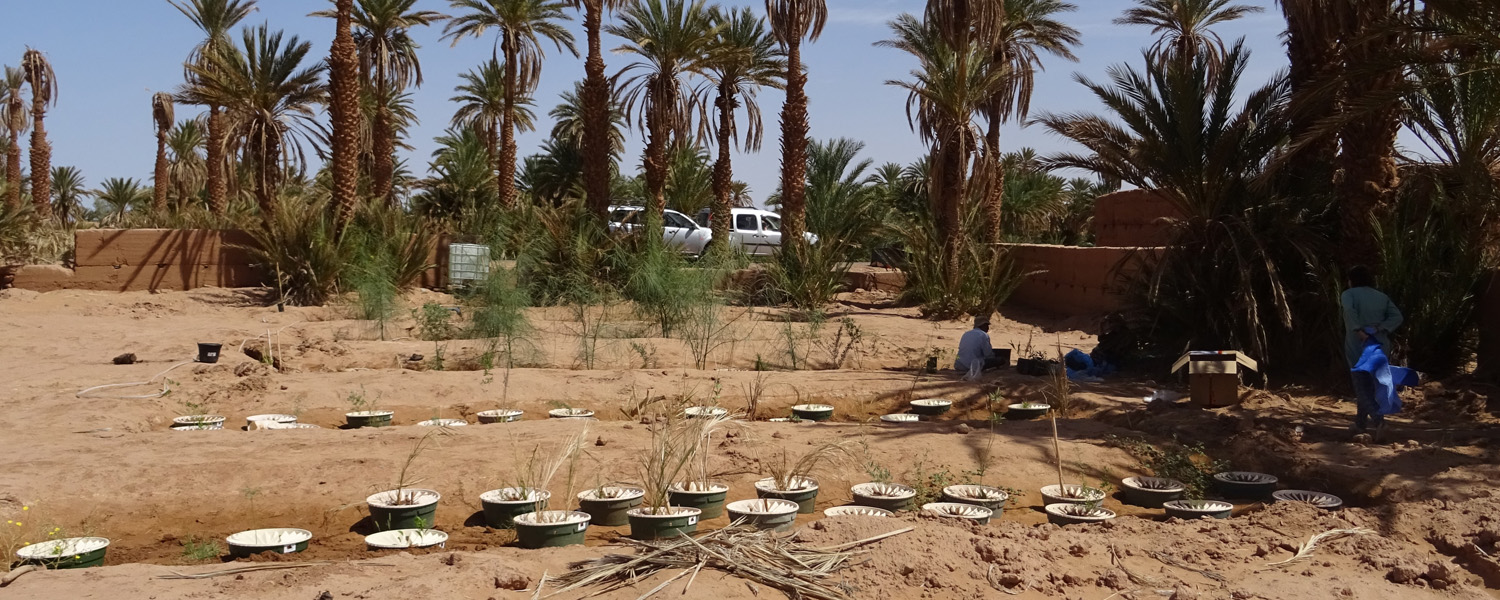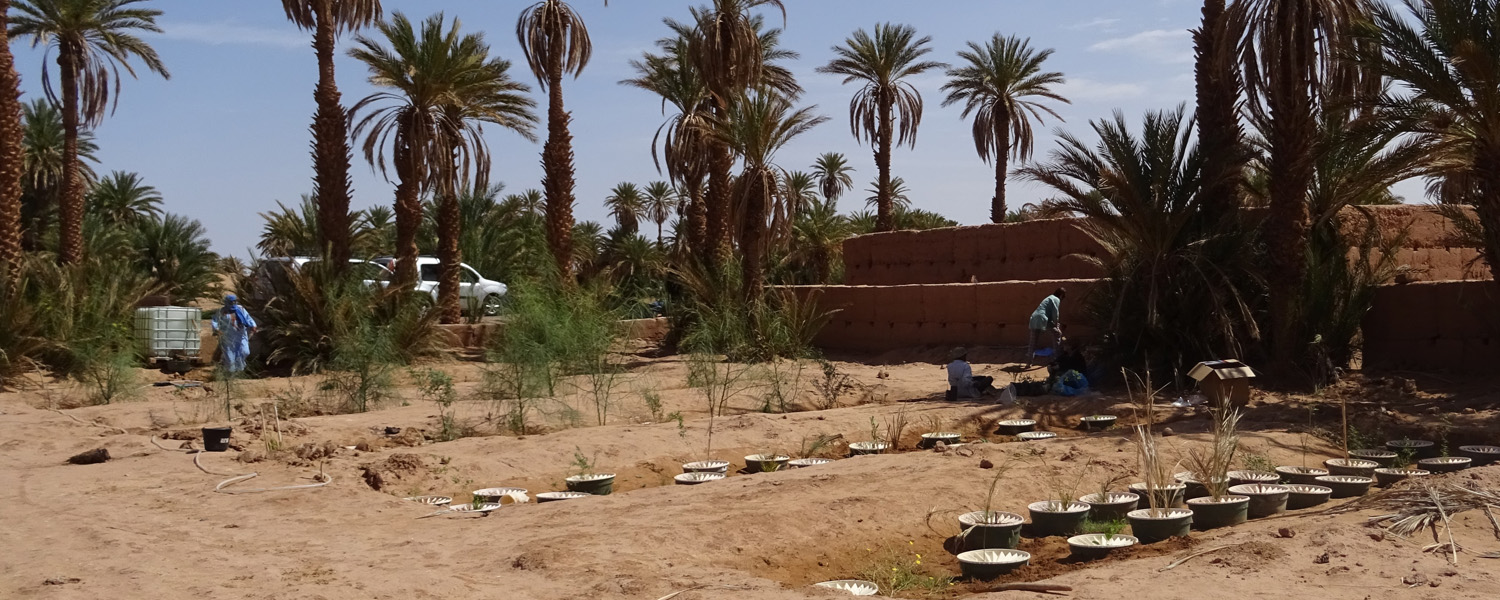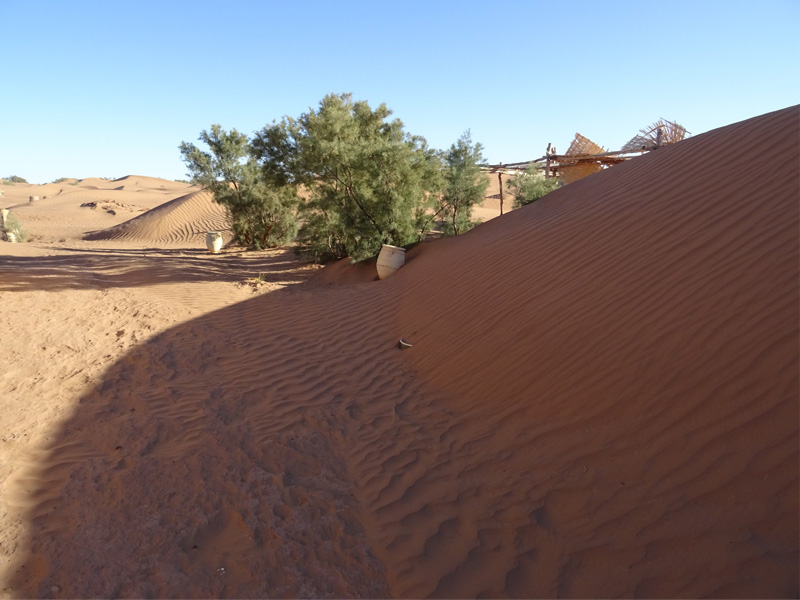Planting trees at the Saharan Desert in Morocco
In February 2019, Wanda Helby made another trip to Marocco to plant trees with Waterboxx/Growboxx with the local people. Please find her Sahara-Roots_newsletter_May_2019.pdf, her travel journey, attached in this article. Passion and pictures!
The Sahara Roots Foundation has been planting more trees with the donated boxes of Green Musketeers in April 2018. Many thanks again to everyone who has donated one or multiple trees via our website! Below, you find the newsletter of the Sahara Roots Foundation, written by Wanda Helby, of May. Enjoy!

The wadi's 4 and 5 that have been planted in April 2018
Earth Day Activities 2018
The Sahara Roots Foundation joined the L’Association Zaila for Culture and Sustainable Development in M’hamid, who had organized a series of activities between 20-22nd April to celebrate International Earth Day 2018 with the support of the Provincial Council of Zagora, the Provincial Ministry of Water and Forests, the Delegation of National Education, Dar America and the communities of Tagounite and M’hamid.
Thirty Groasis Waterboxx® plant cocoons made it to Morocco!
Having arrived at Ouarzazate Airport in the middle of the night and armed with 30 Waterboxx® plant cocoons. The small Sahara-Roots team consisting of Ilham Attar, Anouk Schaedtler and myself, were really surprised that this time the customs made it very difficult for us to enter Morocco with the Waterboxxes. We never had any problems before after showing a photo album to the officials concerned, with information about why we bring the Groasis Waterboxxes into the country: they are for the different projects that we have and are definitely not for sale! After heavy discussions and a promise that next time we would ask permission beforehand from the Ministry of Water and Forest in Zagora, we were finally allowed through with our precious cargo. We felt really responsible for our shipment as most of the Waterboxx® plant cocoons had been donated through the Groasis website and we were seriously worried that they would be taken away from us.
Many thanks to Ilham’s fantastic Arabic negotiation skills!
Buying trees at our favourite nursery
Our first stop during the 6 hour drive to the Sahara, was at our favourite nursery to buy the trees necessary for the planting activities. This time we bought oleanders, jasmine, peppertree, olive trees, pomegranate and roses. We are experimenting with different plants and shrubs to see what will actually grow in the harsh environment where we are planting (in the past we only planted tamarisk acacia and palm trees). We also received small trees from the Ministry of Forestry and Environment and would now be trying to grow mimosa as well as several cocoa-trees. Of course we were really looking forward to visiting the different “project sites” as well as some of the schools where we have planted over the course of the last 5 years with the Groasis Waterboxx® plant cocoon.
The first main activity was planned for the morning of 20 April in Tagounite. In October 2017 we had met with members of the Cultural Club in Tagounite and promised to start a planting project with them. They had planted trees a year before on a site that has been designated as a meeting area for local people and their families, but the trees had not survived the hot summer without water readily available. As you know this is a major problem in the whole of this Saharan area. We now had the Groasis Waterboxx® with us and planned to start this new tree project to help provide shade for the future.
New projects in Tagounite
But as with all of our projects, we first started with educational activities at the primary school of Beni Sbih close by. Halim Sbai of L’Association Zaila and Taragalte, Brahim Aqermim and Thomas Duncan both living in Tagounite, had also joined us to make a start on this project. Brahim and Thomas had both worked with us before and would now be responsible to see how things go in both new planting sites during the coming year. It was wonderful to see them actively involved with the children and their teachers as we explained how the Waterboxx® plant cocoon works, dug holes for the 6 Waterboxxes and planted twelve trees. We planted two trees in each Waterboxx® with the hope that at least one per Waterboxx® would survive. We also donated 20 booklets “Me and my Sahara” to the school explaining that it would be a “tool” to help children understand how important their own environment is.
After a visit to the beautiful Kasbah Bani Sbih, it was time to plant on the site of the Tagounite Culture Centre. Here we planted ten Waterboxxes with seventeen trees of all different varieties including oleander, olive, mimosa, parkinsonia and pepper trees. The local people gather here in the evenings for social events while their children play in the playgrounds provided for them. What a wonderful addition to this community centre.
Renewing relationships at High School M’hamid Center
On the morning of the 21st of April we arrived at High School M’hamid Center and were pleasantly surprised to see that many of the trees we had planted during our activities in the years before had survived well. Teacher Mohamed Chebaibi who had been responsible at that time was now working at a different school and there was also a new headmaster of the school whom we had not yet met. After speaking with him it became apparent that he was eager to learn how the Groasis Waterboxx® plant cocoon worked. The 10 Waterboxx® plant cocoons that we had donated to the school in the past were stacked neatly against the wall ready to be used. As one was broken, we donated a new one as well as we explained how the Waterboxx® works and that the twenty trees, which had been planted in the Waterboxxes over a period of three years, had survived. The headmaster, biology teacher and some students present, all girls, became very enthusiastic about the project and promised to help take care of the newly planted trees. We also donated 20 French “Me and my Sahara” booklets to the school as an incentive for the students to work on taking care of their environment.
10 years of Sahara-Roots!
In the afternoon presentations were given at the Taragalte Cultural Café in M’hamid. Sahara-Roots also gave a presentation celebrating 10 years of Sahara-Roots in this area! We are very proud of what we have been able to accomplish together with the local people.

The 5 wadi's that have been planted in April 2018
Music and traditional dance by students of the Joudour Sahara Music School
As the evening entertainment started with the students of the Joudour Sahara Music School in the Taragalte Cultural Café, we became aware of a change at the “Cultural Center” next door to the Cafe. As we entered the gate we saw that a lot of cleaning up had been done and that someone had been very busy planting trees in the yard. We had also had activities here in April 2016 but had been very disappointed when we came back half a year later, to see that nothing had been done. Now things had changed and a new caretaker was in charge. So we renewed our contact and celebrated the good work by planting two Waterboxx® plant cocoons with trees in the yard.
We then enjoyed music and dance presented by the young students. The next morning we also planted together with the young musicians!
“Green Gateway to the Sahara” project
On our third day in M’hamid the time had finally come to visit our “Green Gateway to the Sahara” pilot project in the village of Zaouia. We were amazed! Habib, our tree-caretaker, had really worked hard. Even in the 3 days that we had been in M’hamid we had experienced two days of sandstorms, let alone the amount of sandstorms that had taken place since October 2017. We had seen the results of these sandstorms at the bivouac where we were staying; many trees were disappearing under the sand. Even one of the tent-sites within the camp had been immersed under the sand.
But the trees in the Groasis Waterboxxes in their wadi’s on this site looked great! Most of the trees had survived well and we could see the Parkinsonia and Pomegranate flowering. Habib was really proud of his work and the fact that this project would serve as an example to other farmers. We were also amazed to see that Habib had planted a “wall of tamarisk trees” around his own piece of land, something that we have been trying to point out to many of the farmers in this area. If each farmer were to plant a “wall of tamarisk” around their own piece of land to hold the encroaching sand back, maybe we can fight the desertification of the oasis fields in which the farmers grow their crops.
Planting and re-planting
By the time we had finished planting and re-planting trees and shrubs that had not survived; we had 75 Groasis Waterboxx® plant cocoons in 5 wadi’s filled with acacias, parkinsonia, pomegranate, mimosa, peppertrees, olive trees, oleander, bougainvillea, rosemary and roses. Palm trees were planted outside of the Waterboxxes but in the vicinity so that they would be able to distract water from the area of the waterboxx. We have found out in the process of planting palm-trees over a period of 5 years that the survival rate is better if they are planted outside of the Waterboxx® plant cocoon. The palm-trees that we use come from this oasis.
“Catch 22”
The water we use for the planting site comes from a well with brackish water and is carried by donkey and cart in small water reservoirs to the 2 large tanks on the site as there is no water-well onsite. In the future we hope to find the funding to build a large water-reserve for water catchment. Occasionally it rains very hard in the Sahara but unfortunately there are no means for water-catchment yet. However if there were to be an underground reservoir in which water can be held, we could use this water instead of distracting ground water causing the groundwater level to become lower and lower. It really is a “Catch 22” situation!
Small man-made oasis around Bivouac Le Petit Prince, M’hamid
The area around Bivouac Le Petit Prince, the camp where we always stay during our time in M’hamid has now become a small man-made oasis. Even though the fight with moving sand-dunes is continuous, and we have lost half of our precious trees to the sand, we are grateful for the 192 trees that have survived. It has become clear that in all the years that we have been planting here, two sides of the camp are very difficult to plant and two sides are doing very well. The encroaching sand dunes travel with the ever prevailing winds which mainly blow in one direction, carrying the sand particles which are deposited where there is an obstruction of some kind, a building or trees. Sahara Roots has not planted around the bivouac since April 2016 but we were happy to see that the local people working here have continued to do so and thus now carry on with the work that we started.

Walking sand dunes in M'hamid
Greening the sports fields in Zagora
On our way back to Ouarzazate we stopped in Zagora to visit biology teacher Adil Moumane at the Sidi Ahmed Benacar Lycee. In October 2017 we were already impressed by his commitment to help make his school greener together with other teachers and students involved and we felt gratified to now be able to hand over 10 new Groasis Waterboxx® plant cocoons to help with “greening” the sports field area where the other waterboxx’s were planted.
A great job done by all!
Minimum use of water and a maximum of effort
Our last stop would be to visit Mr. Mohamed Khattouch, the director of the Institute de Technologie Hoteliere et Touristique (ISTAHT) in Ouarzazate. As we entered the school we were greeted by the vice president of the school (as Mr Mohamed was unfortunately not present), who led us around the school showing all the great work that had been done so far in developing the grounds of this school. We had planted the first trees in Waterboxxes in April 2012 and since then they had replanted each year. Now the school is developing ways to become an “Eco School” and this is visible on the grounds with herb gardens, newly planted trees in different areas of the school in the Waterboxxes. This has also become a pilot-project to show students and visitors at the school that with a minimum use of water and a maximum of effort, you can receive wonderful results!
We are grateful to all who participated during these events and we hope that you may join us again (in whatever way) in trying to make this wonderful world we live in, just a little greener!!
A special thanks those who donated towards our projects through Groasis and Sahara-Roots directly.
Wanda Hebly, 3rd of May 2018
Sahara Roots Foundation
For more information, please visit:
www.sahara-roots.org
For more pictures of the second plantation, please click here. Do you want to donate a tree? Please click here. To read more about this project in the newsletter of May 2018 of the Sahara Roots Foundation, please click here.















